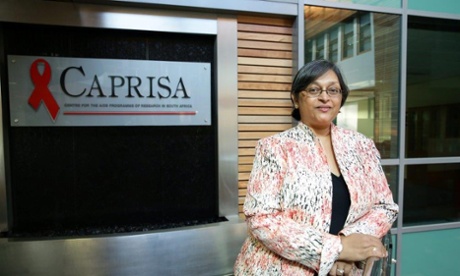Source: The Guardian
Last weekend Quarraisha Abdool Karim, one of South Africa's top HIV researchers, became the first woman to receive a US$100,000 (£62,000) prize for developing world scientists.
The prize is a welcome recognition for the 54-year-old epidemiologist.
Abdool Karim has devoted her career to developing tools that African women can use to protect themselves against HIV. She is involved in developing a battery of new methods, including anti-HIV gels and long-term injectables.
One of the main challenges has been how to prevent HIV infection of young women, who in South Africa have the greatest risk of contracting HIV. Most HIV prevention methods, such as condoms, faithfulness or abstinence, are difficult for women to control. In rural areas, where farming is falling out of fashion, women often don't earn money, and sex frequently becomes a form of currency.
In 1990 Abdool Karim led South Africa's first community-based survey of HIV infection in the KwaZulu-Natal province on the country's east coast. At the time, HIV was a silent epidemic in South Africa, with few carriers showing symptoms. Deaths from Aids only became commonplace in the late 90s, nearly 20 years after the disease was first discovered in the US.

Quarraisha Abdool Karim, who has won the World Academy of Sciences prizePhotograph: PR
The HIV prevalence in South Africa was low back then (around 1%) compared to current rates (over 12% nationwide in 2012). But Abdool Karim found that HIV infection rates shot up quickly in girls aged 15-19 years old, while the prevalence among boys only started climbing in their late 20s. Why did the girls have HIV but not the boys?
"It could only be that the younger girls were having sex with men from the older age group," says Abdool Karim. It was one of the first descriptions of what became known as the "age-sex" difference in HIV acquisition in sub-Saharan Africa. Other studies found that older men sleeping with teenage girls was key driver of the HIV epidemic in Africa.
The age-sex gap has proven tricky to address. Abdool Karim found in her studies of the epidemic that even when girls and women knew the risks involved, HIV wasn't an overriding fear. "Aids six or seven years down the line was less of a priority than survival today," she says.
Working with sex workers, Abdool Karim had the idea of a HIV barrier gel that women could use to prevent themselves from HIV. She'd heard about microbicides – compounds that can be put inside the vagina or rectum to protect against sexually transmitted infections. The first one she tested, a spermicide called Nonoxynol-9, didn't stop HIV. Nor did the second one, a gel containing a drug known as PRO2000.
However, on 20 July 2010, South African researchers led by Quarraisha and her husband, Salim Abdool Karim, unveiled the first global results showing that a microbicide could protect against HIV. In clinical trials of a gel containing the anti-retroviral drug Tenofovir, the women using the gel reported a 39% reduction in HIV infections, compared with those using a placebo gel.
The study also found that among women who were high-adherers (who used the gel over 80% of the time before and after intercourse) HIV infections dropped by 54%. A confirmatory trial of the Tenofovir gel is underway, and if successful the vaginal gel could fill a gap in HIV prevention for women who may not be able to insist on condoms or faithfulness from their partners.
Other tools being tested by Abdool Karim and her colleagues might have higher rates of protection. One is a ring that is fitted around the cervix containing a powerful anti-retroviral called Dapivirine. Abdool Karim is part of an international trial of the product managed by the International Partnership on Microbicides and the Microbicide Trials Network. Another is a three-monthly injection for HIV prevention.
There are also long-term plans to evaluate therapies combining HIV prevention with other medical technologies, for instance birth control. Successful outcomes from these studies could give women a variety of options for protecting themselves against HIV, Abdool Karim says. Options are important, she adds, as what works for one woman may not be suitable for another.
Prevention remains the key to curbing HIV in South Africa. Anti-retroviral rollout in South Africa has changed HIV from a death sentence to a chronic but manageable disease. But rates of new HIV infections exceed treatment rates. The HIV prevalence has remained at about 30% despite the fact that the numbers on treatment increased from about 48,000 in 2003 to close to 2.6 million Aids patients on treatment in 2012. "We can't treat our way out of the epidemic," says Abdool Karim.
